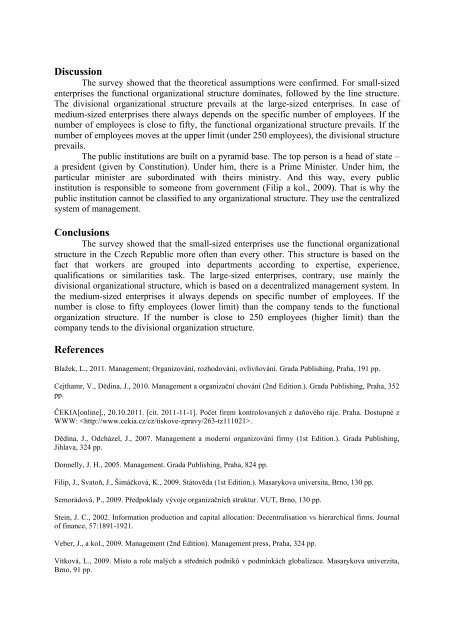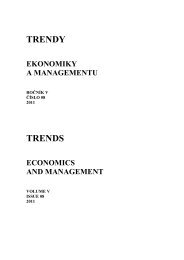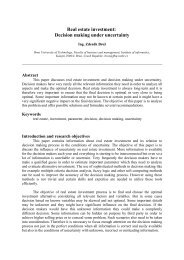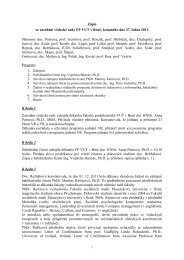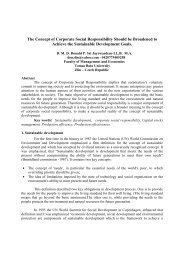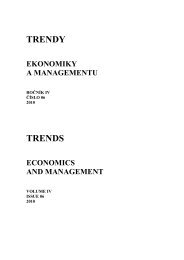Research into the usage of organizational structures in the Czech ...
Research into the usage of organizational structures in the Czech ...
Research into the usage of organizational structures in the Czech ...
Create successful ePaper yourself
Turn your PDF publications into a flip-book with our unique Google optimized e-Paper software.
Discussion<br />
The survey showed that <strong>the</strong> <strong>the</strong>oretical assumptions were confirmed. For small-sized<br />
enterprises <strong>the</strong> functional <strong>organizational</strong> structure dom<strong>in</strong>ates, followed by <strong>the</strong> l<strong>in</strong>e structure.<br />
The divisional <strong>organizational</strong> structure prevails at <strong>the</strong> large-sized enterprises. In case <strong>of</strong><br />
medium-sized enterprises <strong>the</strong>re always depends on <strong>the</strong> specific number <strong>of</strong> employees. If <strong>the</strong><br />
number <strong>of</strong> employees is close to fifty, <strong>the</strong> functional <strong>organizational</strong> structure prevails. If <strong>the</strong><br />
number <strong>of</strong> employees moves at <strong>the</strong> upper limit (under 250 employees), <strong>the</strong> divisional structure<br />
prevails.<br />
The public <strong>in</strong>stitutions are built on a pyramid base. The top person is a head <strong>of</strong> state –<br />
a president (given by Constitution). Under him, <strong>the</strong>re is a Prime M<strong>in</strong>ister. Under him, <strong>the</strong><br />
particular m<strong>in</strong>ister are subord<strong>in</strong>ated with <strong>the</strong>irs m<strong>in</strong>istry. And this way, every public<br />
<strong>in</strong>stitution is responsible to someone from government (Filip a kol., 2009). That is why <strong>the</strong><br />
public <strong>in</strong>stitution cannot be classified to any <strong>organizational</strong> structure. They use <strong>the</strong> centralized<br />
system <strong>of</strong> management.<br />
Conclusions<br />
The survey showed that <strong>the</strong> small-sized enterprises use <strong>the</strong> functional <strong>organizational</strong><br />
structure <strong>in</strong> <strong>the</strong> <strong>Czech</strong> Republic more <strong>of</strong>ten than every o<strong>the</strong>r. This structure is based on <strong>the</strong><br />
fact that workers are grouped <strong><strong>in</strong>to</strong> departments accord<strong>in</strong>g to expertise, experience,<br />
qualifications or similarities task. The large-sized enterprises, contrary, use ma<strong>in</strong>ly <strong>the</strong><br />
divisional <strong>organizational</strong> structure, which is based on a decentralized management system. In<br />
<strong>the</strong> medium-sized enterprises it always depends on specific number <strong>of</strong> employees. If <strong>the</strong><br />
number is close to fifty employees (lower limit) than <strong>the</strong> company tends to <strong>the</strong> functional<br />
organization structure. If <strong>the</strong> number is close to 250 employees (higher limit) than <strong>the</strong><br />
company tends to <strong>the</strong> divisional organization structure.<br />
References<br />
Blažek, L., 2011. Management; Organizování, rozhodování, ovlivňování. Grada Publish<strong>in</strong>g, Praha, 191 pp.<br />
Cejthamr, V., Děd<strong>in</strong>a, J., 2010. Management a organizační chování (2nd Edition.). Grada Publish<strong>in</strong>g, Praha, 352<br />
pp.<br />
ČEKIA[onl<strong>in</strong>e]., 20.10.2011. [cit. 2011-11-1]. Počet firem kontrolovaných z daňového ráje. Praha. Dostupné z<br />
WWW: .<br />
Děd<strong>in</strong>a, J., Odcházel, J., 2007. Management a moderní organizování firmy (1st Edition.). Grada Publish<strong>in</strong>g,<br />
Jihlava, 324 pp.<br />
Donnelly, J. H., 2005. Management. Grada Publish<strong>in</strong>g, Praha, 824 pp.<br />
Filip, J., Svatoň, J., Šimáčková, K., 2009. Státověda (1st Edition.). Masarykova universita, Brno, 130 pp.<br />
Semorádová, P., 2009. Předpoklady vývoje organizačních struktur. VUT, Brno, 130 pp.<br />
Ste<strong>in</strong>, J. C., 2002. Information production and capital allocation: Decentralisation vs hierarchical firms. Journal<br />
<strong>of</strong> f<strong>in</strong>ance, 57:1891-1921.<br />
Veber, J., a kol., 2009. Management (2nd Edition). Management press, Praha, 324 pp.<br />
Vítková, L., 2009. Místo a role malých a středních podniků v podmínkách globalizace. Masarykova univerzita,<br />
Brno, 91 pp.


